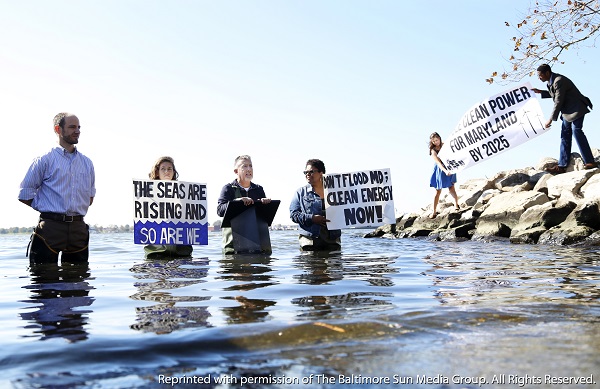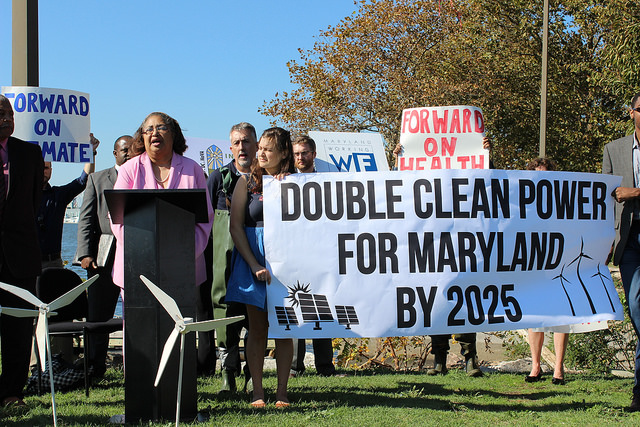 In early 2015, the Maryland Public Service Commission (PSC) will hold hearings on the proposed merger between Exelon Corporation and Pepco Holdings, Inc. (Pepco). The proposed merger would make Exelon—already a top political spender in Maryland and a company with a track record of opposing many clean energy policies—the largest utility company in Maryland and the nation.
In early 2015, the Maryland Public Service Commission (PSC) will hold hearings on the proposed merger between Exelon Corporation and Pepco Holdings, Inc. (Pepco). The proposed merger would make Exelon—already a top political spender in Maryland and a company with a track record of opposing many clean energy policies—the largest utility company in Maryland and the nation.
The PSC must sign off on the merger before it can proceed, which makes it vitally important that all Marylanders become aware of the facts around this case, and voice their concerns now.
 Below is a list of ten facts on the proposed merger and Exelon’s track record that debunk common myths.
Below is a list of ten facts on the proposed merger and Exelon’s track record that debunk common myths.
Click here to view a printable PDF version of the memo.
Fact #1: This merger is NOT a done deal.
It’s a myth that a merger of this type is something that would be hard for the PSC to deny. Nothing could be further from the truth. In fact, the Maryland PSC has a track record of blocking mergers that threaten the public interest.
In 1997, Pepco attempted to merge with Baltimore Gas & Electric Co. (BGE), but the two companies walked away from the deal after the Maryland PSC ordered that the merged company would have to slash electric rates by hundreds of millions of dollars to protect the public. Similarly, FPL Group (now NextEra) tried and failed to acquire Constellation Energy (owner of BGE) in Maryland in 2006. Also in 2006, a proposed merger between Exelon and Public Service Enterprise Group, a New Jersey-based electric utility, was rejected by that state’s Board of Public Utilities after New Jersey officials determined that “the proposed merger would result in a company that is so large, and controls such a significant segment of the gas and electric generation markets, that it could exert market power to drive up energy prices for all New Jersey ratepayers.”[1]
The market power concerns are just as prevalent now. The merger between Exelon and Pepco would give Exelon control over 23.4% of the transmission service activity within our electricity grid region.[2] It is very plausible that with enough surfacing of the facts, Maryland’s PSC could deny the merger or impose enough conditions that the companies decide to walk away. The most important thing right now is that all concerned Maryland residents and businesses make their concerns clear so that they can be fully considered by the PSC.
Fact #2: Exelon is NOT promising to improve Pepco’s reliability goals.
Pepco has a poor track record when it comes to reliability, and many Marylanders are looking for a change. But it’s a myth that Exelon is proposing to do anything more than Pepco. In their merger application, Exelon stated that the company will be “committing to implement Pepco’s current plan to improve system reliability.” In other words, Exelon will do what Pepco was already planning to do anyway. Pepco Holdings has total assets worth $14.8 billion and the company earned $4.7 billion in annual operation revenue in 2013.[3] Exelon is not bringing new ideas to the table to improve reliability, and if Pepco believes that they need outside help to improve their service, the company can use its significant financial resources to hire consultants and contractors to do exactly that.
Fact #3: Exelon publicly champions ANTI-renewable energy policies.
Although Exelon holds some renewable energy assets, solar and wind power account for only 3.7% of the corporation’s total energy resources.[4] It’s a myth that Exelon considers clean energy a top priority. Publicly, the company champions anti-renewable energy policies. Exelon calls itself a “leading voice against the extension of the Production Tax Credit [PTC],”[5] which is the primary federal incentive for promoting land-based wind energy. The PTC is a reasonable way of keeping wind costs down, and by opposing it, Exelon is helping to shift those costs to states like Maryland that have current renewable electricity goals in place. At the same time, Exelon advocates for anti-free market reforms to support their aging nuclear fleet. In 2014 in Illinois, Exelon lobbyists floated the idea of allowing their nuclear plants in that state, which are 35 years old on average, to receive “clean energy credits” like solar and wind.[6] Such a policy would essentially end support for those renewables in favor of Exelon’s decades-old nuclear fleet, which comprise 52% of its generation assets. Later that year Exelon lobbied for a resolution (HR 1146) that required state agencies to devise state funding mechanisms to keep the company’s unprofitable nuclear stations afloat. The resolution directed state agencies to develop “market-based solutions that will ensure that the premature closure of [Exelon’s] nuclear power plants does not occur and that the dire consequences to the economy, jobs, and the environment are averted.”
Fact #4: Exelon’s proposed “Customer Investment Fund” would SHORTCHANGE Maryland.
It’s a myth that Exelon is promising Maryland a $100 million “customer investment fund,” as touted by some commentators. The $100 million would be spread across Maryland, Delaware, New Jersey, and the District of Columbia. Only $40 million would be spent in Maryland, of which $29 million would be spent in the “Pepco” service territory and $11 million would be spent in the Delmarva Power & Light (DPL) territory. Exelon estimates that the money could be spent on bill credits, assistance for low-income customers and energy-efficiency measures, but they do not mention that the proposed $40 million is substantially less than what Pepco utilities already spend on those programs each year.
To put the proposed fund in perspective, Pepco spent $67 million on energy efficiency programs in 2013, including $3.4 million on programs for low-income customers. DPL spent $19 million on energy efficiency programs in 2013, including $2.7 million on programs for low-income customers. Combined, Pepco and DPL spent $86 million on energy efficiency programs in 2013. Pepco and DPL also invested $23 million and $5.7 million respectively in “demand response” programs to decrease energy consumption in their service territories during the highest electricity demand periods.[7] Combined, Pepco and DPL spent $28.7 million on demand response programs in 2013. They invested those funds as part of their EmPOWER Maryland energy efficiency obligations, which are managed by the PSC. Rather than approve the merger and trigger $40 million to be spread across the state, the PSC can and should set nation-leading energy efficiency goals for Pepco, DPL, and Exelon’s subsidiary, BGE, and order them to invest at levels necessary to achieve those goals.
Fact #5: A bigger utility would mean LESS competition—and, potentially, higher rates—for Maryland.
If Exelon merges with Pepco, the Chicago-based corporation would become the largest electric utility in the U.S. It’s a myth that a bigger utility is better for Maryland. The merged utility would provide electricity to over 80% of Maryland ratepayers yet the parent company—Exelon Corporation—would continue to operate the largest fleet of aging nuclear power plants in the country. These nuclear plants have been struggling in recent years due largely to slack energy demand and low electricity rates. This creates a conflict of interest. Exelon would be in charge of keeping electricity rates low for Maryland customers at the same time as their nuclear power plants need to receive higher electricity rates to stay in business. The independent market monitor for PJM, our region’s electricity grid operator, and officials from both Delaware and the District of Columbia have raised concerns that this merger could give Exelon anti-competitive monopolistic power over the electricity market.[8] If this merger is approved, there is a risk that Exelon could use its substantial market power over the regional electric transmission infrastructure to control access to the wholesale electricity market or affect the competitiveness in the wholesale electricity market where the company operates power plants.
Fact #6: Exelon’s track record on efficiency is WORSE than Pepco’s.
It’s a myth that Exelon would do better on energy efficiency. Exelon’s only commitment to energy efficiency in this merger is to “maintain and promote [Pepco’s] existing energy efficiency and demand response programs.” It should be noted that Exelon’s subsidiary, BGE, has a worse energy efficiency track record than Pepco in Maryland. In their 2014 EmPOWER Maryland Energy Efficiency report, the Maryland Public Service Commission projected that the Pepco Holdings subsidiaries, Pepco and Delmarva Power & Light, would achieve 99% and 199% of their 2015 energy savings goals respectively and 96% and 830% of their 2015 peak demand production goals respectively. By contrast, Exelon’s BGE is projected to achieve only 67% of its 2015 energy savings goals and 76% its 2015 peak demand production goals.[9] Similarly, in Illinois, where Exelon is the dominant utility, the company is projected to achieve a dismal 35% to 47% of the statutory efficiency goals in its electricity service territory over the next three years.[10] Exelon has made no specific commitments to improve its performance and its record indicates a lack of commitment to energy efficiency.
Fact #7: The merger could JEOPARDIZE job security for Maryland workers.
It’s a myth that Exelon is promising not to fire employees. While Exelon has committed to no “net” involuntary merger-related job losses of Pepco utility employees for at least two years after the merger, that is very different from saying that they will not fire any Pepco employees. Pepco has 5,000 employees in the mid-Atlantic region. If, for example, Exelon fired 100 lineman after the merger but hired 100 managers, the net number of employees would remain the same (5,000) even though 100 people lost their jobs. Exelon has not made any commitments to retain individual Pepco employees beyond a handful of highly paid executives. Workers are not being promised job security for the next two years, and when the “net employment” commitment period expires, workers will lose even that small token of job protection.
Fact #8: Exelon’s shaky financial footing puts Maryland ratepayers at RISK.
It’s a myth that Exelon would lower rates. For all Pepco’s problems, they are a financially sound company and they do not need a merger to stay afloat. By contrast, Exelon is in a precarious financial position that is overly reliant on an aging and uneconomic nuclear fleet. While Exelon and Pepco have said that they expect the merger to create “synergies” that will create “cost saving opportunities,” they have not identified how those cost savings will be achieved or how those savings will be identified or verified.
Exelon has steadily seen its market value shrink for the last several years, and it is difficult to see how this merger would fundamentally change the company’s risky market position. Exelon Corporation’s shares have declined in value by 30% in the last five years, while shares in Pepco Holdings have risen by 79% over the same period.[11] Fitch Ratings announced a negative warning on Exelon’s credit rating on the day the merger was announced, saying that they “did not consider the acquisition of [Pepco] to meaningfully lessen [Exelon’s] business risk.”[12] If the merger is approved and Exelon’s credit rating declines, Maryland ratepayers could see a rate hike down the line as Exelon faces higher costs of borrowing.
Fact #9: This merger is far different—and RISKIER—than Exelon’s 2012 merger with Constellation.
Exelon did merge with Baltimore-based Constellation Energy in 2012, but it’s a myth that Exelon’s current merger proposal is just a repeat of 2012. The circumstances now are very different. In 2008, Constellation was beset with credit concerns following the Great Recession as the company saw its stock and market value plummet by 56%. The threat of bankruptcy was imminent and the company owned some very risky generation assets. While Pepco is facing challenges in improving reliability and customer service, there is no imminent threat to the company’s financial viability. Pepco stock has increased by 79% in the last five years. This merger is more about Exelon trying to hedge their own risky market position, and should be looked at very differently from the merger that Maryland approved in 2012.
Fact #10: Exelon’s claims on jobs are SHAKY at best.
It’s a myth that this merger would create jobs. In their filing with the PSC, Exelon claimed that the merger will create 6,300 to 7,200 jobs across Maryland. Six thousand of those jobs, though, are expected to come from “enhanced reliability commitments.” Earlier in the application Exelon committed only “to implement Pepco’s current plan to improve system reliability.” So Exelon is committing to create 6,000 jobs by doing what Pepco already said they would do without the merger. Another 1,200 jobs are expected to come from energy efficiency measures through a “customer investment fund.” But Exelon already has energy efficiency programs in Maryland and Illinois, where they run local utilities, and they’re falling short on their statutory goals in both states. Rather than approve this merger, the Maryland PSC can and should set nation-leading energy efficiency goals for Pepco and Exelon’s subsidiary, BGE, and order them to invest at levels necessary to achieve those goals.
For more information please contact:
- James McGarry, Chief Policy Analyst, Chesapeake Climate Action Network, at 240-396-1983 or James@chesapeakeclimate.org
- Tyson Slocum, Energy Program Director, Public Citizen, at 202-454-5191 or Tslocum@citizen.org
1. “Public Advocate and Rate Counsel Oppose Currently Proposed PSEG-Exelon Merger.” State of NJ Division of the Rate Counsel, 26 Apr. 2006. <http://www.state.nj.us/rpa/news/2006/060426_pseg_exelon_merger.html>
2. “Comments of the Independent Market Monitor for PJM.” Before the Federal Energy Regulatory Commission. Docket No. EC14-96-000. 21 Jul 2014. <http://www.monitoringanalytics.com/reports/Reports/2014/IMM_Comment_EC14-96-000_20140721.pdf>
3. Pepco Holdings, Inc. Form 10-K: ANNUAL REPORT PURSUANT TO SECTION 13 OR 15(d) OF THE SECURITIES EXCHANGE ACT OF 1934 For the Fiscal Year Ended December 31, 2013. Rep. U.S. Securities and Exchange Commission, 28 Feb. 2014. <http://services.corporate-ir.net/SEC.Enhanced/SecCapsule.aspx?c=62854&fid=9298222>
4. Exelon Corporation. Form 10-K: ANNUAL REPORT PURSUANT TO SECTION 13 OR 15(d) OF THE SECURITIES EXCHANGE ACT OF 1934 For the Fiscal Year Ended December 31, 2013. Rep. U.S. Securities and Exchange Commission, 14 Feb. 2014. <http://www.exeloncorp.com/performance/investors/secfilings.aspx>
5. Exelon Corporation. Proc. of Edison Electric Institute Financial Conference. N.p., 12 Nov. 2013. Web. <http://www.exeloncorp.com/performance/investors/events.aspx>
6. Daniels, Steve. “Exelon Warns State It May Close 3 Nukes.” Crain’s Chicago Business. 3 Mar. 2014. <http://www.chicagobusiness.com/article/20140301/ISSUE01/303019987/exelon-warns-state-it-may-close-3-nukes>
7. Maryland Public Service Commission. The EmPOWER Maryland Energy Efficiency Act STANDARD REPORT OF 2014. Rep. N.p., Mar. 2014. Web. <http://webapp.psc.state.md.us/intranet/Reports/2014%20EmPOWER%20Maryland%20Energy%20Efficiency%20Act%20Standard%20Report.PDF>
8. District of Columbia: “Comments of the Office of the People’s Counsel for the District of Columbia.” Before the Federal Energy Regulatory Commission. Docket No. EC14-96-000. 21 Jul 2014. Delaware: “Protest of the Delaware Public Service Commission.” Before the Federal Energy Regulatory Commission. Docket No. EC14-96-000. 21 Jul 2014.
9. Maryland Public Service Commission. The EmPOWER Maryland Energy Efficiency Act STANDARD REPORT OF 2014. Rep. N.p., Mar. 2014. Web. <http://webapp.psc.state.md.us/intranet/Reports/2014%20EmPOWER%20Maryland%20Energy%20Efficiency%20Act%20Standard%20Report.PDF>
10. Hinman, Jennifer M. “Re: Question about ComEd Energy Efficiency Goals.” Message to James McGarry. 22 Sept. 2014. E-mail.
11. PEPCO Holdings, Inc. (POM) and Exelon Corporation (EXC) Stock Chart, 5-year history. 22 Oct. 2009 – 22 Oct. 2014. <http://www.google.com/finance?q=EXC%2C+POM&ei=zmBOVKCtJcmt8gbXkoDYCw>
12. “Fitch Places Exelon’s Ratings on Negative Watch Following Acquisition Announcement.” Business Wire, 30 Apr. 2014. <http://www.businesswire.com/news/home/20140430007060/en/Fitch-Places-Exelons-Ratings-Negative-Watch-Acquisition#.VCx8AfldVnY>




 In early 2015, the Maryland Public Service Commission (PSC) will hold hearings on the proposed merger between Exelon Corporation and Pepco Holdings, Inc. (Pepco). The proposed merger would make Exelon—already a top political spender in Maryland and a company with a track record of opposing many clean energy policies—the largest utility company in Maryland and the nation.
In early 2015, the Maryland Public Service Commission (PSC) will hold hearings on the proposed merger between Exelon Corporation and Pepco Holdings, Inc. (Pepco). The proposed merger would make Exelon—already a top political spender in Maryland and a company with a track record of opposing many clean energy policies—the largest utility company in Maryland and the nation. Below is a list of ten facts on the proposed merger and Exelon’s track record that debunk common myths.
Below is a list of ten facts on the proposed merger and Exelon’s track record that debunk common myths.
